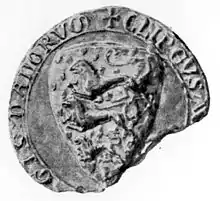Danish Census Book
The Danish Census Book or the Danish book of land taxation (Latin: Liber Census Daniæ), (Danish: Kong Valdemars Jordebog) dates from the 13th century and consists of a number of separate manuscripts. The original manuscripts are now housed in the Danish National Archives (Rigsarkivet) in Copenhagen. [1] [2]

History
The land registration was commissioned during the reign of King Valdemar II of Denmark (1202–1241). The registry contains notes for practical use in the Royal Chancery of the Kingdom of Denmark. It consists of a collection of information regarding Royal income and properties. The book is one of the most important sources of information in regard to social conditions and place names during the Middle Ages. Many locations in Denmark, northern Germany, southern Sweden and northern Estonia were recorded in writing for the first time.[3]
See also
References
- Ole Fenger. "Kong Valdemars Jordebog". Gyldendals og Politikens Danmarkshistorie. Retrieved December 1, 2018.
- "Kong Valdemars jordebog og den nyere kritik". Historisk Tidsskrift, Bind 4. række, 5 (1875 - 1877). Retrieved December 1, 2018.
- Scandinavians in History By Stanley Mease Toyne; p 73 ISBN 0-8369-5302-9
Related reading
- Jespersen, Knud J. V. (2011) A History of Denmark (Palgrave Macmillan) ISBN 978-0230273429
- Lauring, Palle (1986) A History of Denmark (Nordic Academic Press)ISBN 978-8714286958
- Murray, Alan V. (2009) The Clash of Cultures on the Medieval Baltic Frontier (Ashgate Publishing, Ltd.) ISBN 978-0754664833
External links
- Nielsen, Oluf (red.) (1873) Liber Census Daniæ. Kong Valdemar den Andens Jordebog (Copenhagen: Gads Forlag)